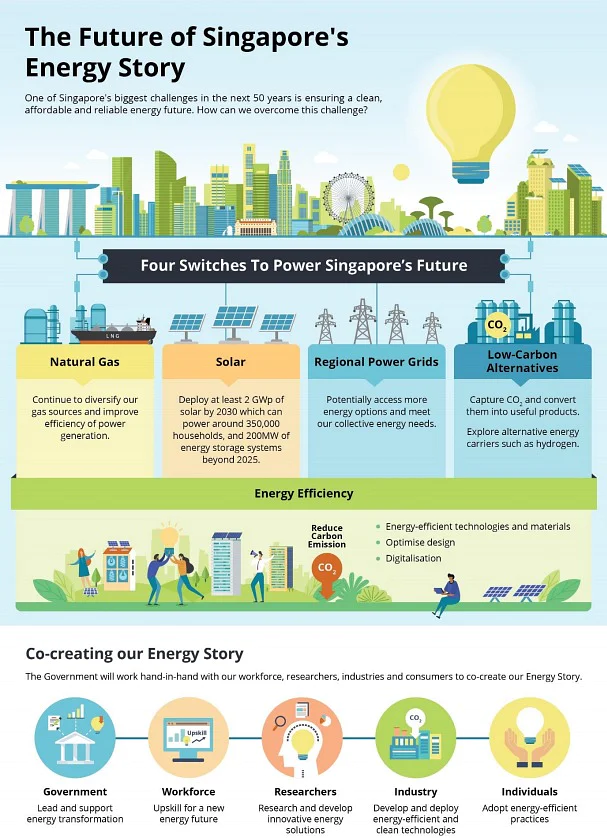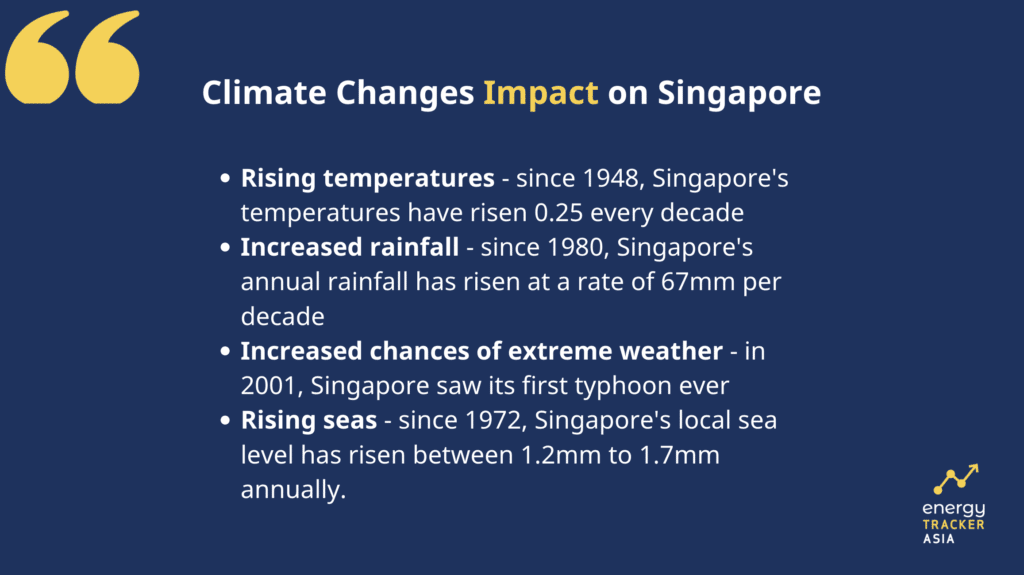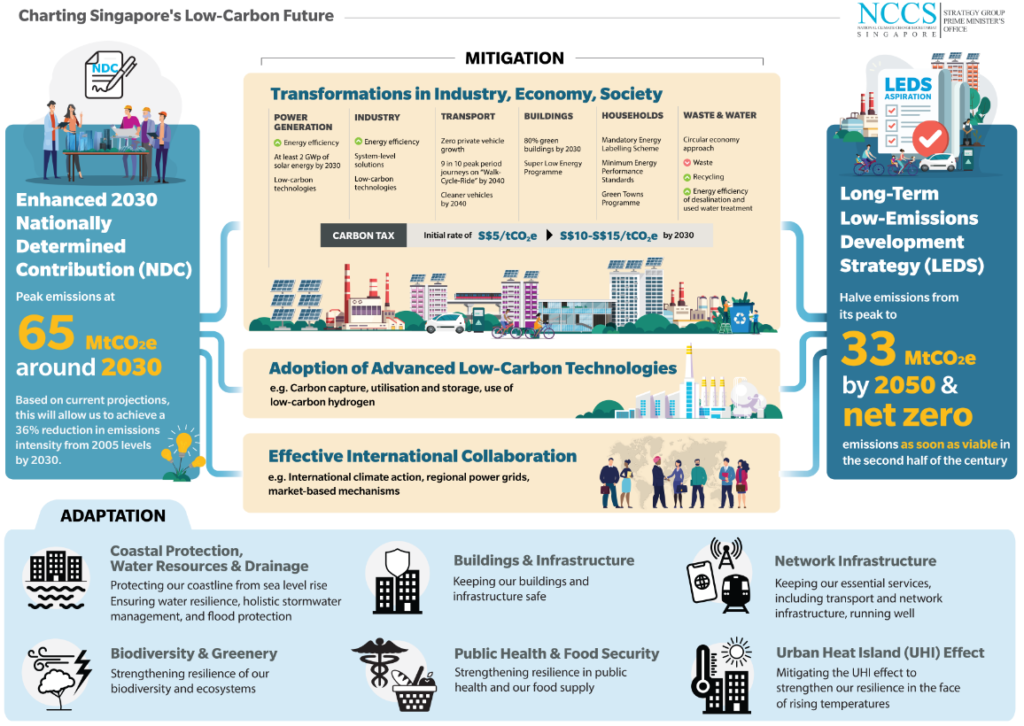Climate Change in Singapore: Impact, Response and Goals
Source: Bloomberg
09 June 2024 – by Eric Koons Comments (0)
Climate Change in Singapore 2024
Climate change in Singapore is a hot topic. Not only is the country one of the financial centres of Asia’s energy transition, but it is also at risk from significant climate impacts. The island country’s low-lying geography means rising sea levels and increasing rainfall create a significant flash floods risk. Additionally, its tropical location means rising temperatures pose a real threat to human health.
The need for climate action is more than apparent. And while nearly 80% of Singaporeans are willing to do more to help mitigate climate change, the country has a “critically insufficient” rating in the latest Climate Action Tracker Assessment.
What Causes Climate Change in Singapore?
Climate change in Singapore is caused by a combination of global factors such as greenhouse gas emissions, urbanization, and industrialisation. Population density and heavy reliance on fossil fuels for energy generation contribute significantly to Singapore’s carbon footprint. Deforestation is an another cause.
Effects and Impact of Climate Change in Singapore:
Singapore is already seeing the effects of climate change such as heat stress, intense rainfall, urban heat island effect and extreme weather patterns. While the impacts of global warming are still relatively mild, they are at risk of snowballing as greenhouse gas emissions increase, leading to a climate feedback loop. The current issues Singapore experiences as a result of climate change include:
- higher temperatures – a 0.25-degree increase per decade from 1948 onwards,
- increasing warm days – the number of warm days has been growing annually since 1972,
- more extreme and increasing rainfall – average annual rainfall has been increasing at a rate of 67mm per decade since 1980,
- extreme weather events – new unpredictable wind (2001 saw the first typhoon ever in Singapore)
- and sea level rise – since 1972, local sea levels have risen 1.2 mm to 1.7 mm annually.
Future Climate Impacts in Asia – Temperature and Sea Level Rise
If global emissions rates do not decline, these climate change impacts will continue to become more extreme. As a result, they will pose significant challenges to the island nation. It is impossible to predict all of the potential future impacts, but experts do largely agree on a few general trends and estimations.
The Centre for Climate Research Singapore predicts that if nothing changes, there will be an increase in the daily mean temperature by up to 4.6 degrees Celsius by 2100. Additionally, this will be accompanied by a sea level rise of 1 meter.
Furthermore, extreme weather patterns will increase – longer and more intense wet months with hotter dry months. As a result, experts worry about the impacts on agriculture and human health, as well as damage to natural environmental systems and challenges with managing existing water resources.
Is Singapore Doing Enough to Reduce Carbon and Greenhouse Gas Emissions and Combat Global Warming?
While Singapore is taking steps toward combating climate change, the country needs to do more. The country is still heavily reliant on natural gas, and some of the country’s largest banks are still funding fossil fuel projects. That being said, the initial plans are in place for the country to reach its goals of reducing emissions intensity by 36% by 2030 and achieving net-zero during the second half of the century.
Efforts to Combat Global Warming in Singapore
To reduce Singapore’s role in climate change, the country is introducing several policies that limit GHG emissions.
First and foremost, Singapore is actively switching away from coal and oil. Currently, nearly 95% of the country’s electricity needs come from natural gas, aiming to increase the role that true renewable energy sources play. Singapore will mainly focus on harnessing solar energy and aims to achieve at least 2 GW of solar capacity by 2030. Additionally, the country’s energy future will heavily rely on importing renewable energy from surrounding countries and harnessing other low-carbon alternatives.

Another primary focus is reducing the emissions that local industries generate to combat climate change. This is being targeted with two approaches: tracking energy efficiency and applying a carbon tax. Businesses in the industry and transportation sectors must appoint an energy monitor, monitor and report greenhouse gas emissions, and regularly assess options to improve energy efficiency. The country’s carbon tax is applied uniformly across all industries and puts a price on each ton of CO2 generated. The tax will increase in 2024.
In line with these significant policies, Singapore is applying several other GHG-reducing strategies, including phasing out internal combustion vehicles by 2040, improving the country’s recycling rate, developing efficient wastewater treatment facilities, and actively testing emerging low-carbon technologies.
Preparing For Inevitable Impacts of Climate Change
Even with these efforts, Singapore will be affected by climate impacts within the next several decades. How serious these impacts of climate are, will be dictated by global emissions reduction efforts. In preparation, the country is applying a variety of adaptation efforts:
- increasing the minimal land reclamation height from 3 to 4 meters,
- implementing erosion control methods like stone embankments,
- developing water resource management infrastructure (desalinisation, catchment, etc.),
- redeveloping the country’s stormwater drainage system,
- and improving food security by growing local and diversifying import sources

Moving Towards Energy Transition
While the recent Climate Action Tracker Assessment marks Singapore’s effort to limit climate change consequences as insufficient, it is clear that the country is making an effort. The country’s recent policies and stance on climate change, like increasing the local carbon tax, are hopeful signs. As a financial leader in Asia, Singapore has a significant role to play in the region’s energy transition.

by Eric Koons
Eric is a passionate environmental advocate that believes renewable energy is a key piece in meeting the world’s growing energy demands. He received an environmental science degree from the University of California and has worked to promote environmentally and socially sustainable practices since. Eric’s expertise extends across the environmental field, yet he maintains a strong focus on renewable energy. His work has been featured by leading environmental organizations, such as World Resources Institute and Hitachi ABB Power Grids.
Read more




